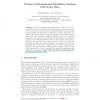Free Online Productivity Tools
i2Speak
i2Symbol
i2OCR
iTex2Img
iWeb2Print
iWeb2Shot
i2Type
iPdf2Split
iPdf2Merge
i2Bopomofo
i2Arabic
i2Style
i2Image
i2PDF
iLatex2Rtf
Sci2ools
RECOMB
2007
Springer
2007
Springer
Protein Conformational Flexibility Analysis with Noisy Data
Abstract. Protein conformational changes play a critical role in biological functions such as ligand-protein and protein-protein interactions. Due to the noise in structural data, determining salient conformational changes reliably and efficiently is a challenging problem. This paper presents an efficient algorithm for analyzing protein conformational changes, using noisy data. It applies a statistical flexibility test to all contiguous fragments of a protein and combines the information from these tests to compute a consensus flexibility measure for each residue of the protein. We tested the algorithm, using data from the Protein Data Bank and the Macromolecular Movements Database. The results show that our algorithm can reliably detect different types of salient conformational changes, including well-known examples such as hinge and shear, as well as the flap motion of HIV-1 protease. The software implementing our algorithm is available at http://motion.comp.nus.edu.sg/projects/ prof...
Computational Biology | Conformational Changes | Protein Conformational Changes | RECOMB 2007 | Salient Conformational Changes |
| Added | 03 Dec 2009 |
| Updated | 03 Dec 2009 |
| Type | Conference |
| Year | 2007 |
| Where | RECOMB |
| Authors | Anshul Nigham, David Hsu |
Comments (0)

